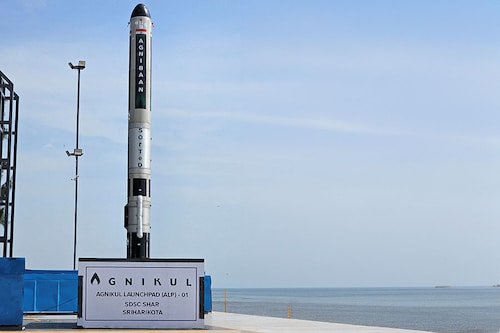Agnibaan-01 soars, boosts private Indian space tech to new heights
The successful test flight demonstrated a world-first single piece 3D-printed engine and India's first semi-cryogenic core


Agnikul Cosmos, a space launch vehicle startup in Chennai, on Thursday successfully launch-tested its first technology demonstrator rocket that showed its one-piece 3D-printed engine worked as intended.
The successful test underscores the perseverance of 200-engineer team at Agnikul, led by founders Srinath Ravichandran and SPM Moin, that had to endure four previous scrapped launches, including at the final countdown during an attempt earlier in the week.
The indigenously designed and developed rocket, named Agnibaan, was launched from Sriharikota, home to the Indian Space Research Organisation’s (Isro) launch station, where Agnikul has its own launchpad, named Dhanush, which it set up in 2022.
The rocket, Agnibaan SOrTeD, Sub-Orbital Technology Demonstrator, was launched at 7.15 am. “Humbled to announce the successful completion of our first flight—Mission 01 of Agnibaan SOrTeD—from our own and India’s first and only private Launchpad within SDSC-SHAR at Sriharikota," Agnikul said in a post on X.
Sub-orbital flight refers to altitudes of up to 100 km above the mean sea level, called the Karman Line, which denotes the start of space.
“All the mission objectives of this controlled vertical ascent flight were met and performance was nominal. The vehicle was completely designed in-house and was powered by the world’s first single piece 3D printed engine and also happens to be India’s first flight with a semi-cryo engine," the company said.
“The Department of Space and Isro congratulate Agnikul Cosmos… the success involving many firsts, including 3D printed semi-cryogenic engine, flight control systems etc, demonstrate the prowess of indigenous design and innovation," Isro’s Chairman S Somanath said in a statement. “It motivates Isro to support the space startups and non-governmental entities for innovation and ‘atmanirbharata’ to create a vibrant space ecosystem in the country."
The successful launch, “marks a significant moment for private players who are contributing to growing India"s space sector", Pawan Goenka, chairman of IN-SPACe, said in a statement. India’s space tech innovators are “driving the transformation of the sector" in the country, he added.
Also read: Isro"s journey: From discovering water on the moon to fostering India"s space tech startups
Professor V Kamakoti, director of Indian Institute of Technology (IIT), Madras, said, “very innovative, first time in the world, deep core technology was demonstrated today by Agnikul". This should inspire young students to boldly take the entrepreneurship route and become employers, he added.
Ravichandran and his cricket buddy Moin started Agnikul in 2017. The startup was incubated at the IIT-Madras Research Park, and it went on to raise $67 million in venture capital funding. Investors include Celesta Capital, Mayfield, Rocketship, Pi Ventures and Speciale Invest.
Professor Satyanarayanan R Chakravarthy, head of the National Centre for Combustion Research and Development, IIT-Madras, a founding advisor to Agnikul, said Agnibaan demonstrated “the world’s most integrated single shot 3D printed piece. It signals the ability to rapidly assemble rockets that is unparalleled".
Agnikul has also set up its own rocket engine factory that can turn out an engine in a matter of days. The company is in talks to supply launch vehicles to commercial customers looking to tap the low-Earth-orbit opportunity. It expects to fly an orbital mission in early 2026. It is working with customers on flights planned for next year.
First Published: May 30, 2024, 11:55
Subscribe Now